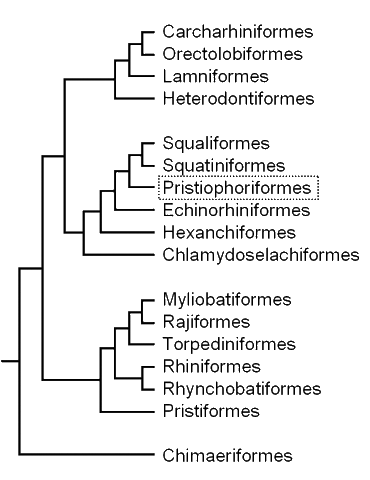Order Pristiophoriformes:
Sawsharks — 8 species

- snout flattened and blade-like, studded along the margins with fine, weakly embedded teeth that usually alternate between long and short (unlike those of sawfishes, in which the rostral teeth are stout, firmly embedded, and fairly uniform in size); the group's scientific name means "saw carrier"
- long nasal barbels located on ventral surface of the rostral saw, about mid-way along its length
- two dorsal fins, without spines
- five (Pristiophorus) or six (Pliotrema) pairs of gill slits, located on side of the head (rather than underneath, as in sawfishes)
- large spiracles (accessory respiratory opening behind each eye)
- lack of an anal fin
- ovoviviparous
- primarily found in marine habitats, but occasionally wander into estuaries; sawsharks range from temperate to tropical zones in the western Atlantic (Florida, Bahamas, and Cuba), the southwestern Indian Ocean (off South Africa), and the western Pacific (from southern Australia and Japan)
- 2 genera in the family Pristiophoridae

|

|

|

A representative pristiophoroid, the Common Sawshark (Pristiophorus cirratus), showing the rostral saw, long nasal barbels, gill slits on the side of the head, and lack of an anal fin that characterizes the group. The inset to the far right is a detail of a rostral tooth, showing the shallow root.
The pristiophoroids look rather like slender sawfishes, but are readily distinguished by a pair of long nasal barbels — resembling a Fu Manchu mustache — hanging from the underside of the 'saw' about mid-way along its length. The saw itself is an extension of the rostral cartilages supporting the snout. The rostral teeth of sawsharks are replaced when broken or lost, unlike those of sawfishes (in which damaged or missing rostral teeth are not replaced). Sawsharks are strongly bottom-oriented, occurring over sand or mud substrates. They apparently use their electrosensitive ampullae of Lorenzini peppering the undersurface of the saw and their highly sensitive nasal barbels to detect buried prey, which they then debilitate with vigorous side-to-side swipes of the rostral saw. Sawsharks have a small, transverse mouth and tiny, cuspidate teeth. Known prey of these sharks includes small fishes (such as gapers and cornetfishes), crustaceans, and squids.

Common Sawshark (Pristiophorus cirratus)
Pristiophoroids grow to a length of about five feet (1.5 metres). Litters of 7 to 17 large pups — 11 to 14 inches (28 to 35 centimetres) long — are born with the long rostral teeth folded back, possibly preventing injury to the mother; smaller rostral teeth erupt between the larger ones after birth. Temperate sawsharks inhabit shallow bays and estuaries, but one tropical species — the Bahamian Sawshark (Pristiophorus schroederi) — occurs at depths from 2 100 to 3,000 feet (640 to 915 metres). Sawsharks are fished commercially off southern Australia — where two species are caught, the Common Sawshark (Pristiophorus cirratus) and the Southern Sawshark (Pristiophorus nudipinnis) — and in the western North Pacific — where the Japanese Sawshark (Pristiophorus japonicus) is highly valued for making "kamaboko" (a traditional Japanese fishcake).
The pristiophoroids include one of the few sharks outside the hexanchoids with more than five pairs of gill slits: the Sixgill Sawshark (Pliotrema warreni), from the southeastern coast of South Africa. All other sawsharks have five pairs of gill slits and are placed in the genus Pristiophorus.
